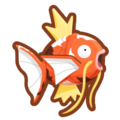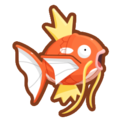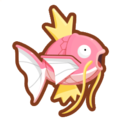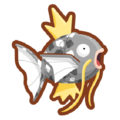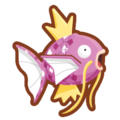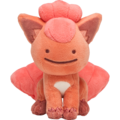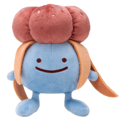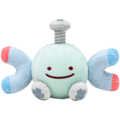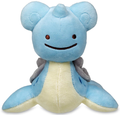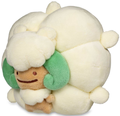Variant Pokémon

|
The subject of this article has no official name. The name currently in use is a fan designator; see below for more information. |
Variant Pokémon are Pokémon who vary in their appearance compared to other Pokémon of the same species. This is often due to gender, diet, special genetic traits or environmental factors such as climate. Certain symbiotic relationships may also play a role in this. Depending on the species, the altered appearance may be purely cosmetic or it may affect how they perform in battles.
While many variances are caused by natural processes, they sometimes can be artificially invoked as well. This may be achieved through the use of physical modifications or behavioral conditioning, or contact with certain items and radiation.
Multiple species
Form differences
- Main article: List of Pokémon with form differences
Form differences are major variations that are officially recognized by the Pokédex.
Shiny Pokémon
- Main article: Shiny Pokémon
Shiny Pokémon are Pokémon with an alternate coloration. They are extremely rare. These Pokémon all have a shining animation at the beginning of the battle when they are sent out or encountered.
Gender differences
- Main article: List of Pokémon with gender differences
From Generation IV onward, there are many Pokémon that appear differently as a result of their gender.
Of these, Unfezant, Frillish, Jellicent, Pyroar, Meowstic, Indeedee, and Basculegion differ so drastically that they even have separate menu sprites and artworks.
Regional forms
- Main article: Regional form
In Generation VII, regional forms made their debut with Alola Form Pokémon. Regional forms are Pokémon that have adapted uniquely to a habitat different than their species normally occupies in the rest of the world. This results in many differences, such as different appearances, types, and Abilities.
Totem Pokémon
- Main article: Totem Pokémon
Totem Pokémon are wild Pokémon that serve as the final hurdle in all trials of the island challenge. They are larger and heavier than other Pokémon of the same species. At the start of battle, the Totem Pokémon is enveloped in a special aura which boosts its stats.
Hisui's Ride Pokémon
- Main article: Hisui's Ride Pokémon
Ride Pokémon are descendants of five of the ten companions of the ancient hero of legend that were all blessed by Arceus in the past. They're often larger than other Pokémon of the same species. During the events of the game, they assist the player who they deem worthy in their mission to "seek out all Pokémon".
Noble Pokémon
- Main article: Noble Pokémon
Noble Pokémon are descendants of five of the ten companions of the ancient hero of legend that were all blessed by Arceus in the past. They're often larger than other Pokémon of the same species. During the events of the game, they all became frenzied due to golden lightning coming from inside Space-time rifts.
Ecologically similar Pokémon
- Main article: Ecologically similar Pokémon
Ecologically similar Pokémon are Pokémon that resemble previously discovered Pokémon in the past. Yet they are completely different despite their similarities.
Titan Pokémon
- Main article: Titan Pokémon
Titan Pokémon are Pokémon that feed on Herba Mystica, rare herbs with amazing healing properties and the capability of making Pokémon grow huge.
Paradox Pokémon
- Main article: Paradox Pokémon
Paradox Pokémon are Pokémon that resemble ancient or futuristic versions of contemporary Pokémon. They were brought into the present by a time machine built by Professor SadaS/Professor TuroV.
Unique Terastallized states
- Main article: Terastal phenomenon → Unique Terastallized states
The two game mascots of Pokémon Scarlet and Violet: The Hidden Treasure of Area Zero, Ogerpon and Terapagos, both have unique Terastallized states.
Pokémon fusions
- Main article: Pokémon fusion
Some Pokémon have been known to combine with other Pokémon or even people.
Giant Pokémon
- Main article: Giant Pokémon
Giant Pokémon are Pokémon that are much larger than usual. Many phenomena can cause giant Pokémon to occur.
Shadow Pokémon
- Main article: Shadow Pokémon
Shadow Pokémon are Pokémon that have had the door to their heart shut artificially by Cipher. They are the only Pokémon capable of using Shadow moves.
Toy Pokémon
- Main article: Toy Pokémon
Toy Pokémon are Pokémon toys given self-awareness by Wonder Keys that appear in the Pokémon Rumble series. They are different to normal Pokémon in many ways; for example, they can only know two moves at a time.
Rusty Pokémon
- Main article: Rusty Pokémon
Over time Toy Pokémon rust, causing them to become Rusty Pokémon. Dark Rust can instantaneously rust Toy Pokémon. Rusty Pokémon can be restored using Glowdrops or the Rust Removal Spot.
Illumina Pokémon
- Main article: Illumina phenomenon
In the game New Pokémon Snap, Pokémon from the Lental region may temporarily exhibit the Illumina phenomenon, where their bodies glow in the presence of Illumina orbs or if in close contact with crystabloom flowers. Some Pokémon, dubbed Illumina Pokémon, are perpetually glowing.
Known Illumina Pokémon include Meganium, Milotic, Wishiwashi, Volcarona, Steelix, and Xerneas.
Cloned Pokémon
- Main article: Cloning
Cloned Pokémon are Pokémon that have been artificially duplicated from another specimen. This process works on both living and fossilized specimens. Many of these clones are not identical to their original specimen: Mewtwo, Bulbasaurtwo, Charmandertwo, Squirtletwo, Pikachutwo, Venusaurtwo, Charizardtwo, Blastoisetwo, and Meowthtwo all display this.
Other known cloned Pokémon are Psyduck, Seadra, Tentacruel, Pidgeot, Scyther, Hitmonlee, Dewgong, Sandslash, Vaporeon, Golduck, Nidoqueen, Ninetales, Vulpix, Vileplume, Wigglytuff, Rapidash, and Rhyhorn.
Mirage Pokémon
- Main article: Mirage Pokémon
Mirage Pokémon are holographic Pokémon created by Dr. Yung. They have only appeared in The Mastermind of Mirage Pokémon.
Valencian Pokémon
In the episode Poké Ball Peril, a number of alternately colored Pokémon were seen on Valencia Island, including Butterfree, Raticate, Nidoran♂, Nidoran♀, Vileplume, Paras, and Weepinbell.
Pink Pokémon
In the episode In The Pink, all of the Pokémon native to Pinkan Island were shown to be colored pink, due to their diet of Pinkan Berries. Pink Pokémon seen on the island include Caterpie, Weedle, Pidgey, Rattata, Pikachu, Nidoran♀, Nidoran♂, Nidoking, Vileplume, Paras, Parasect, Venonat, Diglett, Mankey, Primeape, Bellsprout, Dodrio, Exeggutor, Rhyhorn and Rhydon.
Ash's Pikachu turned partially pink while eating Pinkan Berries.
Further pink Pokémon seen during Team Rocket's fantasy include Pidgeotto, Arbok, Oddish, Poliwhirl, Geodude, Weezing, Scyther and Electabuzz.
Individual species
Arbok
Several of Arbok's Pokédex entries state that its face-like hood markings differ between areas, and that a number of variations have been recorded. Its Pokémon Yellow Pokédex entry mentions that there are six known patterns, but by the events of Pokémon Ultra Sun and Ultra Moon, its Ultra Sun Pokédex entry mentions that there are more than 20. Around eleven designs are known, but only six have appeared in the games, and only three of which appeared in the core series games.
- Standard pattern
The most common, "standardized" hood pattern has red, teardrop-shaped eyes outlined in black with yellow, elongated hearts inside, a black mouth, and a black arrow over the eyes, with two red dots near the tip and an upward-extending tail. This design stems from Arbok's Pokémon Red and Green artwork, itself based on Arbok's sprites from the Generation I games (outside of Pokémon Yellow), only swapping out the red and yellow accents, and removing the extra "pupil" in the two large eyes.
This hood would become the default one in the mainline games starting with Pokémon FireRed and LeafGreen, although this was already the design used in the anime, the manga (except for Agatha's Arbok in Pokémon Adventures), and most pieces of artwork (promotional, Dream World/corporate, etc). In the Pokémon Adventures manga, it is known as the "regenerative pattern", and is seen on Koga's Arbok.
- Other patterns
Arbok also has several hood variations with round eyes and a red mouth outlined in black. The most common depiction of this has two black fangs descending onto its mouth, black eyebrows, and outward-pointing eyelashes. This design first appeared in Arbok's Pokémon Red and Blue artwork, and has also appeared in the Ruby, Sapphire, and Emerald sprites, the TCG cards Arbok from Fossil, Arbok from Expedition, and Janine's Arbok from the VS set.
Another hood variation with round eyes appeared in Gold, Silver, and Crystal, and on the Arbok Coin in Pokémon Trading Card Game 2: The Invasion of Team GR!. This pattern has no fangs or eyebrows, a pointier mouth, and its eyelashes point upward. A similar pattern can be seen in Pokémon Pinball, though this one seemingly lacks eyebrows altogether.
The final unique in-game hood motif appears in Pokémon Ranger. This design has no eyelashes or fangs, and has a Y-shaped mark which branches over each eye and connects to the middle to the mouth. The branches each have smaller, Y-shaped ends, between each of which resides a small black dot.
Illustrations shown in the 1996 book Pocket Monsters Encyclopedia show three other hood designs, which were later used in the Pokémon Adventures manga, in which Agatha's Arbok can change its markings, gaining a special ability in the process. These are the speed, attack, and invulnerability patterns. These hoods were later seen in the Japanese version of episode's Prof. Oak's Pokémon Lecture.
Two additional patterns can be seen in artwork form. The first is from Game Freak's original website, on an illustration depicting Jessie and an Arbok with a motif similar to the main circular one, only with eyes pointing in a different direction. The second design appeared on the sleeve of the GB Sounds CD, featuring diamond-shaped eyes, a slim mouth, and two black marks by the sides of the "face".
An evil-looking pattern was also created by Mitsuhiro Arita solely for the TCG. Both eyes are joined into a sharp red mask, with a yellow outline and triangular pupils. As for the mouth, it is shaped like a grin full of pointed red teeth outlined in black. It is featured in the card Dark Arbok from the Team Rocket set.
Jessie and Arbok artwork
Pikachu
- Main article: Pikachu variants
Almost every Pokémon medium has featured a different Pikachu variant, most notably Surfing and Flying Pikachu.
Vulpix
Several of Vulpix's Pokédex entries mention that newborn Vulpix only have a single white-colored tail. The tail then splits into six orange-colored tails as it matures, and eventually splits from their tips to increase in number even more.
Enta's Vulpix only has one tail in its debut in Enta Arrives at the Battle Frontier!. In the same chapter, its tails split into six.
A one-tailed Vulpix in Pokémon Battle Frontier
Shellder
Shellder can be either a bivalve shell or a spiral-shaped shell, depending on whether or not it is attached to a Slowpoke. Though impossible in the games, multiple Pokédex entries state that a Shellder can be detached from the Slowbro (making it devolve into a Slowpoke) or Slowking (making it lose its memory) it is attached to. This gives them a few more characteristics of Shellder variants than actual evolutions. However, because the Shellder is attached to and evolves with the Slowpoke, after evolution they are treated as one Pokémon. Illustrations shown in An Illustrated Book of POCKET MONSTERS depict other variations, though these are explicitly labeled as an artist's impression of a Slowbro being bitten by a Shellder.
Exeggcute and Exeggutor
Exeggcute are not always seen as a group of six, and the number of heads an Exeggutor has also varies.
Exeggutor is depicted with an extra head on its back in every core series game up until Pokémon FireRed and LeafGreen. In its Pokédex entry for Pokémon Crystal, it is stated that "living in a good environment makes it grow lots of heads". In the early seasons of the anime, it was occasionally depicted with more than three heads, often distributed in a ring around its torso rather than just on the front. In The March of the Exeggutor Squad, an Exeggutor's leaves are cut, revealing five heads. Additionally, official game art during this period also depicted Exeggutor with its heads distributed around its body, though not exceeding three heads. However, from FireRed and LeafGreen onwards, Exeggutor is consistently depicted with three heads on the front, and none on the back across official media.
Eventually, one of Exeggutor's heads will fall off and become a single Exeggcute. This Exeggcute will telepathically communicate with others, in order to join and form a cluster of six. Until they are gathered, Exeggcute won't be able to maintain balance.
Exeggutor's back sprite in Generation I
Exeggutor's back sprite in Generation II
Exeggutor's back sprite in Ruby, Sapphire, and Emerald
Exeggutor with four visible heads in its original series anime art
Exeggutor with five heads in The March of the Exeggutor Squad
Exeggutor with a ring of heads in Red and Green art
Kangaskhan
Kangaskhan's category in Japanese is "Parent and Child Pokémon", implying it consists of two beings. This is ratified by the fact that they are all born with a child in their pouch. The child is purple, and has not yet developed most of the features from its parent, having to stay in the pouch for 3 years. Although Kangaskhan's moves are performed by the parent, some TCG cards (Jungle Kangaskhan, Blaine's Kangaskhan, Aquapolis Kangaskhan, and EX FireRed & LeafGreen Kangaskhan) have attacks that involve or are performed by the child.
When Kangaskhan Mega Evolves into Mega Kangaskhan, the baby emerges from the mother's pouch and is noticeably matured.
Magikarp
In the game Pokémon: Magikarp Jump, Magikarp's scales come in many different patterns in addition to its usual standard and Shiny colorations. These patterns can be classified by groups, depending on how the Magikarp looks while it's still small-sized; a specific pattern arises when it becomes bigger. Which patterns can be caught depend on the Old Rod; the better, the more groups of patterns can be fished.
Ditto copies
When some Ditto transform into another Pokémon, they take on a mild variant form of that Pokémon instead of an exact replica. This happens when Ditto is incapable of changing the face by memory, with the result being a deformed copy of the target Pokémon with a blank, beady-eyed expression.
This appearance was first present in one of Duplica's Ditto, both in the anime and in the Electric Tale of Pikachu manga. It was later seen in Ditto cards from the EX Delta Species expansion of the TCG, in a kind of Clefairy that appears in the Veilstone Game Corner, in Pokémon Snap with three Ditto disguised as Bulbasaur, and in Pokémon Mystery Dungeon: Explorers of Sky in the Special Episode Here Comes Team Charm!.
The merchandise series Ditto Collection features Ditto transformed into a variety of other Pokémon while retaining its face.
Snorlax
In Snorlax Snowman, several ice-blue Snorlax adapted to more frigid climates appeared.
In Pokémon Sleep, Snorlax has a different color in each research site: a regular-colored Snorlax in Greengrass Isle, a green-colored Snorlax in Cyan Beach, a pale-colored Snorlax in Taupe Hollow, a blue-colored Snorlax in Snowdrop Tundra, and a teal-colored Snorlax in Lapis Lakeside.
Spinda
Like Unown, Spinda has many visual variations in its species, all involving the placement of its spots. Like Unown's letter, the spot placement is generated based on the individual's personality value, and likewise, has no effect on the Pokémon's stats. Unlike Unown, however, these differences are rarely repeated, as the calculation uses the entirety of the personality value—a number that can range from zero to 4,294,967,295 (232 - 1). Some personality values can, however, produce the same apparent pattern from differing values. In Pokémon GO, 9 different numbered patterns of Spinda can be found and are registered as distinct forms in the Pokédex.
- Generation III core series
- Pokémon GO
- Other
Kecleon
A purple Kecleon is one of the two Kecleon Brothers in the Pokémon Mystery Dungeon series. He also appeared in the special episodes Pokémon Mystery Dungeon: Team Go-Getters Out of the Gate! and Pokémon Mystery Dungeon: Explorers of Time & Darkness.
In The Kecleon Caper, a purple Kecleon nicknamed Reddy appeared under the ownership of Madison. This Kecleon differs in having normal frills, lips and eye rings.
Celesteela
A baby form of Celesteela appeared in an anime episode Rise and Shine, Starship!.
Unseen variants
Some variants have only been mentioned in Pokédex entries; Pokémon of these variants have not been shown in any Pokémon media.
| Pokémon | Description |
|---|---|
 Charizard |
Charizard's Pokédex entry from Gold states that when Charizard is furious, its tail flares up into a whitish-blue color. This may have been referenced by Mega Charizard X, but it has not been seen otherwise. |
 Weezing |
Weezing's Pokédex entries from Pokémon Diamond, Pearl, and Platinum state that triplets of the species have been discovered. All Weezing have a third gas chamber, though it has no face. |
 Mantyke |
Mantyke's Pokédex entry from Pearl says that the pattern on its back varies from region to region. While it has the same appearance in all Generation IV games (due to using the same sprites), the "face" in the Generation V and VI games appears wider; however, all Mantyke look the same within each game, regardless of origin. |
 Gastrodon |
Gastrodon's Pokédex entry from Pearl says that it used to have a huge shell on its back in ancient times. |
 Genesect |
Genesect's Pokédex entries state that it originally lived 300 million years ago, but was altered by Team Plasma. Although the full appearance of Genesect's original form has not been seen, fossilized parts of it that bear a great similarity to the bodily structure of the modern Genesect appear in Genesect and the Legend Awakened and its manga adaptation. |
 Dreepy |
Dreepy's Pokédex entry from Sword states that it originally lived in prehistoric seas and has been reborn as a ghost Pokémon. Its ancient form has never been seen, so it is unknown how similar it is to its current form. |
 Varoom |
Varoom's Pokédex entry from Scarlet states it is created when an unknown poison Pokémon enters and possesses a scrap engine. The identity of this poison Pokémon is unknown. |
Individual Pokémon
Pink Butterfree
- Main article: Pink Butterfree
A pink Butterfree appeared in Bye Bye Butterfree and paired up with Ash's Butterfree, who then left his Trainer to go with her.
Crystal Onix
- Main article: Crystal Onix
The Crystal Onix is a special individual Onix that lives on Sunburst Island. Its body is made out of glass crystal. Due to being made out of crystal, it is no longer weak to Water-type attacks and instead weak to Fire-type attacks.
Shadow Mewtwo
- Main article: Shadow Mewtwo
In Pokkén Tournament, Shadow Mewtwo is a Mewtwo that had unwillingly merged with and become possessed by a Shadow Synergy Stone, causing its appearance to change. When Anne wields the power of the Synergy Stone contained in her brooch, Mewtwo is separated from the Shadow Synergy Stone and its appearance returns to normal.
Gold Sudowoodo
In All That Glitters is Not Golden!, a Trainer named Keenan owned a Sudowoodo that he had turned to gold during a science experiment, in an attempt to make Sudowoodo immune to Water-type attacks. The changes made to Sudowoodo were eventually reversed.
Shadow Lugia
- Main article: Shadow Lugia
In Pokémon XD: Gale of Darkness, Shadow Lugia, also known as XD001, is a Lugia that had been so thoroughly corrupted by Cipher that its appearance changed. After Shadow Lugia is purified by Michael, its normal appearance is restored.
Meta Groudon
- Main article: Meta Groudon
In Jirachi: Wish Maker, Butler created a being in the image of Groudon using the power of his machine and Jirachi. The Meta Groudon began to absorb all life in Forina until it was defeated by Jirachi.
Green-crystal Deoxys
- Main article: Deoxys (M07)
One of the Deoxys that appeared in Destiny Deoxys had a green crystal instead of a purple one. It also had a green mark on its face instead of a purple one.
Primal Dialga
- Main article: Primal Dialga
In Pokémon Mystery Dungeon: Explorers of Time, Explorers of Darkness, and Explorers of Sky, Dialga became Primal Dialga when it lost control of time due to the collapse of the Temporal Tower. Dialga can regain control of time and revert to its normal self if all the Time Gears are brought to the tower. As Primal Dialga, it is incapable of logical reasoning or showing mercy, only seeking self-preservation and preventing time from flowing properly.
Z2
In the anime, Z2 has a blue core as its Core and in its 10% Forme instead of the red core shown in the official anime art of Zygarde's Formes.
































































